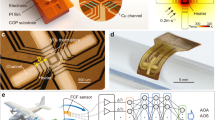Abstract
Conceptual improvements to a non-contact optical strain measurement technique for high-speed flywheels are presented. The improvements include a novel reflective pattern that allows for greater displacement sensitivity, the ability to measure rigid body vibrations and separate the associated vibration-induced displacement from the strain-induced displacement, and the ability to compensate for potential sensor drift during flywheel operation. The effects of rigid body rotor vibrations and sensor drift have been modeled and techniques to compensate for the errors associated with such effects are presented. Experimental results validate the ability of the technique to separate such vibrations from axisymmetric flexible body displacements, and to compensate for errors due to in-plane and out-of-plane pattern misalignment and sensor drift. Displacement measurements made on an aluminum rotor operating at a maximum speed of 16 krpm (255 m/s at the point of measurement) were made with ±1 μm accuracy. At this speed, hoop strains were found to be within 40–125 με of theoretical predictions, provided a proper accounting is made for thermal strains. Relative to the theoretical hoop strains, the measured hoop strains differed by 5.0 to 6.4% at 16 krpm.
Similar content being viewed by others
Abbreviations
- A 0 :
-
axisymmetric radial deformation of rotor due to strain
- A 1 :
-
amplitude of in-plane rigid body radial displacement of rotor
- a :
-
inner radius of aluminum rotor
- b :
-
outer radios of aluminum rotor
- d :
-
shortest distance between edge of a reflective patch and center of illuminated spot
- E :
-
tensile Young's modulus (isotropic)
- r :
-
radial coordinate on rotor
- r′:
-
a particular radial location on the rotor
- r i :
-
inner radius of an annular region of an optical pattern
- r inst :
-
radial location on rotor at instantaneous speed
- r max :
-
maximum radial location at which a hoop strain sensitivity can be achieved
- r o :
-
outer radius of an annular region of an optical pattern
- r ref :
-
radial location on rotor at reference (negligible deformation) speed
- S c :
-
counter frequency (Hz)
- u :
-
radial displacement
- u min :
-
minimum detectable radial displacement
- u rack :
-
radial displacement of sensor rack due to temperature change
- u theory :
-
theoretical displacement of the aluminum rotor
- u tot :
-
total radial displacement including thermal effects
- α:
-
linear coefficient of thermal expansion for an isotropic rotor
- β:
-
phase of in-plane rigid body radial displacement of rotor
- ΔT :
-
temperature change of rotor
- ε r :
-
radial strain (m/m)
- εθ :
-
hoop strain (m/m)
- ϕ:
-
duty cycle (rad)
- ϕinst :
-
duty cycle at instantaneous speed
- ϕref :
-
duty cycle at reference (negligible deformation) speed
- γ:
-
angular position on rotor
- ν:
-
isotropic Poisson's ratio
- ρ:
-
material density
- θmin :
-
rotor rotation during one counter increment (rad)
- θ a :
-
apparent measured compensation patch angle (rad)
- θ c :
-
correct compensation patch angle (rad)
- ω:
-
angular speed of rotor (rad/s)
- Ψ:
-
acute angle between trajectory of illuminated spot and displacement patch boundary
References
Simpson, M.L. andWelch, D.E., “Optoelectronic Strain Measurement System for Rotating Disks,” EXPERIMENTAL MECHANICS,27 (1),37–43 (1987).
Preater, R., “Non-Contact Method of In-Plane Strain Measurement on Rotating Structures,”Proc. Society of Photo-Optical Instrumentation Engineers 1980 European Conference on Optical Systems and Applications,236,58–61 (1980).
Preater, R. andSwain, R., “Preliminary Assessment of the Requirements to Transfer In-Plane ESPI to an Industrial Spinning Pit Facility,”Proc. SPIE—The International Society for Optical Engineering Interferometry VI: Applications, July 14–15, 1993, San Diego, CA,2004,142–149 (1993).
Ferrero, C., Genta, G., andMarinari, C., “Experimental Strain Measurements on Bare Filament Flywheels,”Composites,14 (4),359–364 (1983).
Ferrero, C., Genta, G., Marinari, C., andRonco, C., “Experimental Study of the Stress Distribution in the Spokes of Bare Filament Flywheels,”Composites,16 (4),286–292 (1985).
Morganthaler, G. F. and Bonk, S. P., “Composite Flywheel Stress Analysis and Material Study,” Proc. 12th Natl. SAMPE Symp., Soc. for Advancement of Materials and Process Engrg., Covina, CA, paper no. D5 (1967).
Hoeltzel, D.A., Stark, R., and Ali, S., “Voltage to Frequency Conversion for Telemetric Strain Measurements in Rotating Mechanical Systems” Experimental Techniques, 18–24, July/August (1993).
Saito, Y., Kato, H., andYoshikawa, K., “Strain Analysis of a Rotating Plate with X-Ray Diffraction Techniques,” EXPERIMENTAL MECHANICS,33 (1)21–24 (1993).
Gabrys, C.W. andBakis, C.E., “Design and Manufacturing of Filament Wound Elastomeric Matrix Composite Flywheels,”J. Reinforced Plastics and Composites,16 (6),488–502 (1997).
Ehrich, F., Handbook of Rotordynamics, Krieger Publishing Co., Malabar, FL, 3.55–3.57 (1999).
Timoshenko, S.P., Theory of Elasticity, 3rd Edition, McGraw Hill Book Co., New York, 81–82 (1934).
Emerson, R.P., “Viscoelastic Behavior of Composite Flywheel Rotors,” Ph.d. dissertation (in progress), Dept. of Engineering Science and Mechanics, The Pennsylvania State University (2002).
Author information
Authors and Affiliations
Rights and permissions
About this article
Cite this article
Emerson, R.P., Bakis, C.E. Optoelectronic strain measurement for flywheels. Experimental Mechanics 42, 237–246 (2002). https://doi.org/10.1007/BF02410978
Received:
Revised:
Issue Date:
DOI: https://doi.org/10.1007/BF02410978




